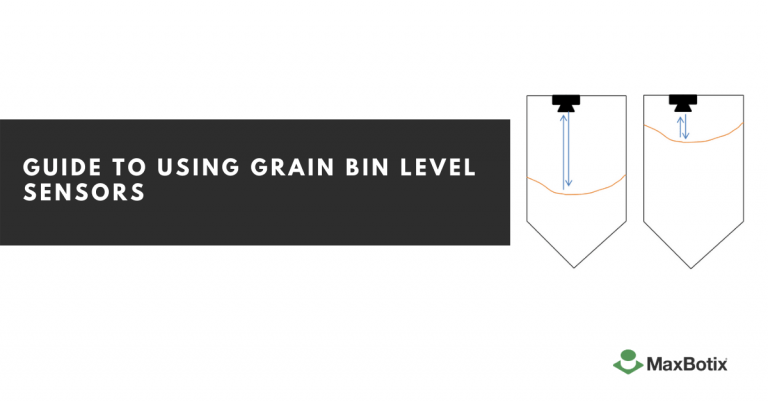 When developing a sensor solution to detect levels in a bin, there are a wide variety factors you need to keep in mind. The way that sensors detect certain materials will influence your decision on the sensors you use for your application.
In this quick guide we're going to cover how ultrasonic sensors are used in a grain silo level detection application.
When developing a sensor solution to detect levels in a bin, there are a wide variety factors you need to keep in mind. The way that sensors detect certain materials will influence your decision on the sensors you use for your application.
In this quick guide we're going to cover how ultrasonic sensors are used in a grain silo level detection application.
How Grain Detection Works in Silos
While detecting bulk solids in a grain silo, not only is the mounting of the sensor important, also the levels of the grains play a factor in the accuracy of the continuous level measurement.
When using ultrasonic technology as continuous level sensors, these following scenarios will help your application succeed or help you understand the limitations of using this sensor type as grain level indicators.
The level of grain in a bin affects how well and how accurately the levels will be detected by level monitors.
Ideal Ultrasonic Bin Level Use

|

|
|
1. As the bin is 3/4 Full: Typically, there is a level enough surface that allows the sound to be reflected back to the sensor, that will allow the distance to be grain to be reported accurately. |
2. As the bin is 1/2 Full: Typically, there is a level enough surface that allows the sound to be reflected back to the sensor, that will allow the distance to be grain to be reported accurately. |
Potential Issues with Ultrasonic Silo Level Sensing

|

|
|
3. Near Empty Silo Level Measurement The shape of the grain may be deflected away from the sensor because it is not on a level surface. This may cause a max range reading to be reported. |
4. Full Bin Silo Level Measurement The shape of the grain up close may cause the sound to be deflected away from the sensor. This may also cause a max range reading to be reported. |
Mounting the Grain Level Sensor
It's important to have the sensor mounted in a way that will allow the sensor to detect the surface of the target without any obstruction. This will allow you to detect the presence or absence of material in the tank or silo.Recommended Sensor Mounting
Typically the best mounting is to have the sensor offset from the center of the bin by at least several inches. Smooth walls are important because cube corner reflections can cause incorrect range readings. Do not mount the sensor too close to the side of the bin because phase cancellation of the sound wave may cause incorrect range readings to occur.
Navigating Corner Reflectors
Our sensors have a narrow beam pattern which reduces the chance the sensor will detect the silo wall. This all depends on the diameter of your silo. If the tank is corrugated or doesn’t have smooth inside walls, it will likely have a negative impact on the performance of the sensor. The sensor cannot be mounted too close to corrugated walls otherwise it will impact the performance of the sensor's level measurement.Notes on Detecting Up Close Targets
Applications requiring 100% reading to reading reliability should not use MaxSonar sensors at a distance closer than the minimum report distance. Many users have found MaxSonar sensors to work reliably from 0 mm to the minimum reported distance in many applications, MaxBotix Inc. does not guarantee operational reliability for objects closer than the minimum reported distance. Due to physics relating to ultrasonic technology, these sensors are unable to achieve 100% reliability at close distances.
Notes on Grain Types
In general cracked corn, pellets and chicken crumbles, all have a very systematic fall pattern. This means the inverted cone was generally pretty uniform and provided a good return. Pig mash can have a fall pattern that is more unpredictable. It would sometimes "cliff" where it is almost a vertical wall. When this happens, the sensor either detects the top or the bottom of the inverted cone depending on the sensor location.Ultrasonic Sensor Recommendation for Silo Level Monitoring Systems
For the best results with grain, use the MB7051Our Collaborators currently working in Grain Detection Applications
Milesight Read more about the solution here: https://www.maxbotix.com/articles/ultrasonic-level-lorawan-sensor.htm Ultrasonic Distance / Level Sensor EM500-UDL Milesight's EM500-UDL is an outdoor environment monitoring sensor mainly used to measure distance without object interface contact. This battery-powered solution is designed for various mounting needs. The types of solutions served:- Grain Silo Level Monitoring
- Tank Level Monitoring
- Water/Snow Level Monitoring
 Aranet
Read More about Aranet's Solution here: https://www.maxbotix.com/articles/wireless-distance-sensor.htm
Ultrasonic Distance Sensor
Aranet's ultrasonic distance sensor uses ultrasound to measure the distance to targets. Applications served include a wide range of liquid and non-liquid materials.
The types of industries served:
Aranet
Read More about Aranet's Solution here: https://www.maxbotix.com/articles/wireless-distance-sensor.htm
Ultrasonic Distance Sensor
Aranet's ultrasonic distance sensor uses ultrasound to measure the distance to targets. Applications served include a wide range of liquid and non-liquid materials.
The types of industries served:
- Livestock Farming
- Fish Faring
- Storage Facilities
- Horticulture

Not sure if our sensors would be the right fit for your application?
Click the button below to contact our team to discuss your project needs.


